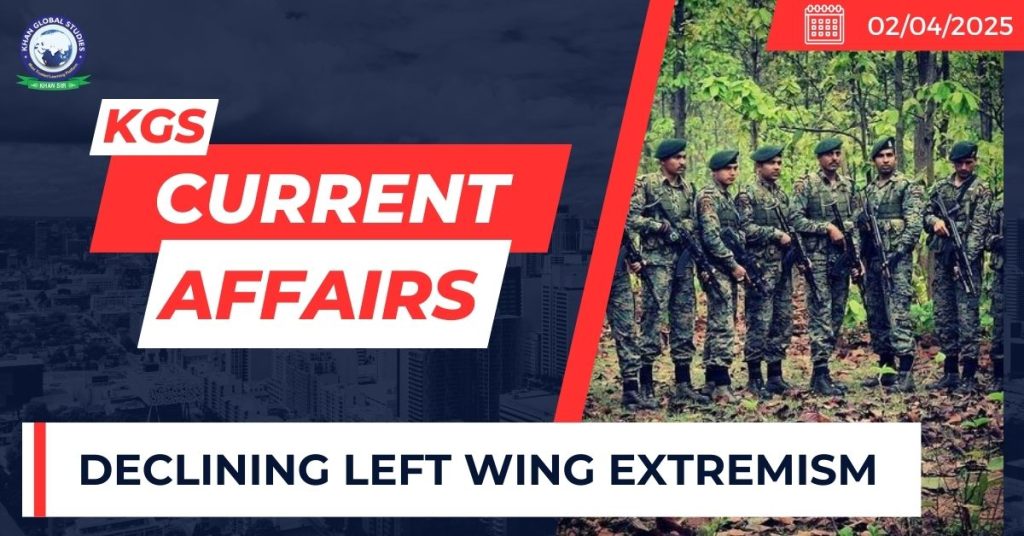Context:
Recently, the Union Home Minister announced that the most Left-Wing Extremism-affected districts have been reduced to just to 6 from 12.
More on the News
India is determined to uproot Naxalism for good by 31st March 2026.
The total number of districts affected by Naxalism in the country was 38. Among these

- The number of most affected districts has reduced to 6 from 12.
- Remaining districts are Bijapur, Kanker, Narayanpur, and Sukma from Chhattisgarh , West Singhbhum from Jharkhand , and Gadchiroli from Maharashtra.
- The number of Districts of Concern has also come down to 6 from 9.
- These 6 districts of Concern along with their state are: Andhra Pradesh (Alluri Sitarama Raju), Madhya Pradesh (Balaghat), Odisha (Kalahandi, Kandhamal, and Malkangiri), and Telangana (Bhadradri-Kothagudem).
- The number of Other LWE-affected Districts has also been reduced from 17 to 6.
- Remaining districts are Dantewada, Gariaband, and Mohla-Manpur-Ambagarh Chowki from Chhattisgarh, Latehar from Jharkhand, Nuapada from Odisha and Mulugu from Telangana.
- The most affected Districts and Districts of Concern are given financial assistance of Rs. 30 crore and Rs. 10 crore, by the central government under Special Central Assistance (SCA) to fill the gaps in public infrastructure.
About Left-Wing Extremism (LWE)
LWE is based on a dangerous ideology that utilises violence and propaganda with the aim to establish a classless society by overthrowing the Government in power.
LWE emerged in 1967 in Naxalbari, Phansidewa, and Khoribari of West Bengal’s Darjeeling District.
- The term ‘Naxal’ originates from the village of Naxalbari in West Bengal.
- Naxal, Naxalite, and Naxalvadi are generic terms that refer to various militant Communist groups operating in different parts of India under different organizational structures.
Eradication of Left Wing Extremism
A “National Policy and Action Plan” was approved in 2015 to envisage a multi-prolonged strategy involving security-related measures, development interventions, ensuing rights and entitlements of local communities etc.
- In Chhattisgarh, violence perpetrated by LWE have reduced by 47% in 2024 in comparison to the high levels of 2010 (2024: 267, 2010: 499).
- The resultant deaths (Civilians + Security Forces) have also reduced by 64% during the same period (2024: 122, 2010: 343).
SAMADHAN Doctrine is the one-stop solution for the LWE, it was introduced by the Ministry of Home Affairs in 2017:
- Smart Leadership
- Aggressive Strategy
- Motivation and Training
- Actionable Intelligence
- Dashboard-Based KPIs (Key Performance Indicators) and KRAs (Key Result Areas)
- Harnessing Technology
- Action Plan for Each Theatre
- No Access to Financing
Security Related Expenditure (SRE) Scheme: Under it funds are provided to LWE affected families of civilian/Security Forces killed in LWE violence, training and operational needs of Security Forces, rehabilitation of surrendered LWE cadres, community policing, compensation to Security Force personnel/civilians for property damage by LWE.
- Under this scheme Rs. 1925.83 crore have been released to all LWE affected States during last 5 years (between 2019-20 to).
- This includes Rs. 773.62 Crore for Chhattisgarh.
Further, Rs. 654.84 crore have been given to Central Agencies during the last 05 years (2019-20 to 2025) for helicopters and addressing critical infrastructure in security camps in LWE affected areas, under Assistance to Central Agencies for LWE Management (ACALWEM) Scheme.
Special Infrastructure Scheme (SIS): Strengthening of Special Forces, Special Intelligence Branches (SIBs) and District Police is undertaken under this scheme.
- Rs. 394.31 crore have been released to all LWE affected States during last 5 years (between 2019-20 to 2025).
Tribal Youth Exchange Programs (TYEPs) are also being organized through Nehru Yuva Kendra Sangathan (NYKS) for integration of tribal youth of LWE affected districts with National mainstream.

